I just finished this little baby sweater, which I did technically finish, though that’s about all I did. Someone came into the yarn store recently with this project that their mother had started for the mother’s great-grandchild (this lady’s grandchild), and had all but finished. Her mother had since passed, the needles had been removed, the pattern lost, but the project had just been found and she was looking for someone to fix it up for her. It was mostly a matter of picking up stitches, fixing a few dropped stitches, and knitting a short collar. It was a pretty quick project, but rewarding when I think of how much it will mean to the woman who brought it in.
Shawl time!
There I was, minding my own business, sleeping, when a shawl pattern decided it wanted to be knit, now. It announced that it was a lace shawl, with a certain shape, but unspecified lace pattern. I managed to convince it that we could start out without the lace, to check that I could get the shape right, and, well, this is the result. Since I wasn’t doing lace, I went to my shawl yarn stash (as opposed to the sock, hat, or weaving yarn one) and found this-it’s Pearl from Lorna’s Laces, a 51% silk and 49% bamboo blend in the color Blue Tulle. I’m very happy with this use for it!
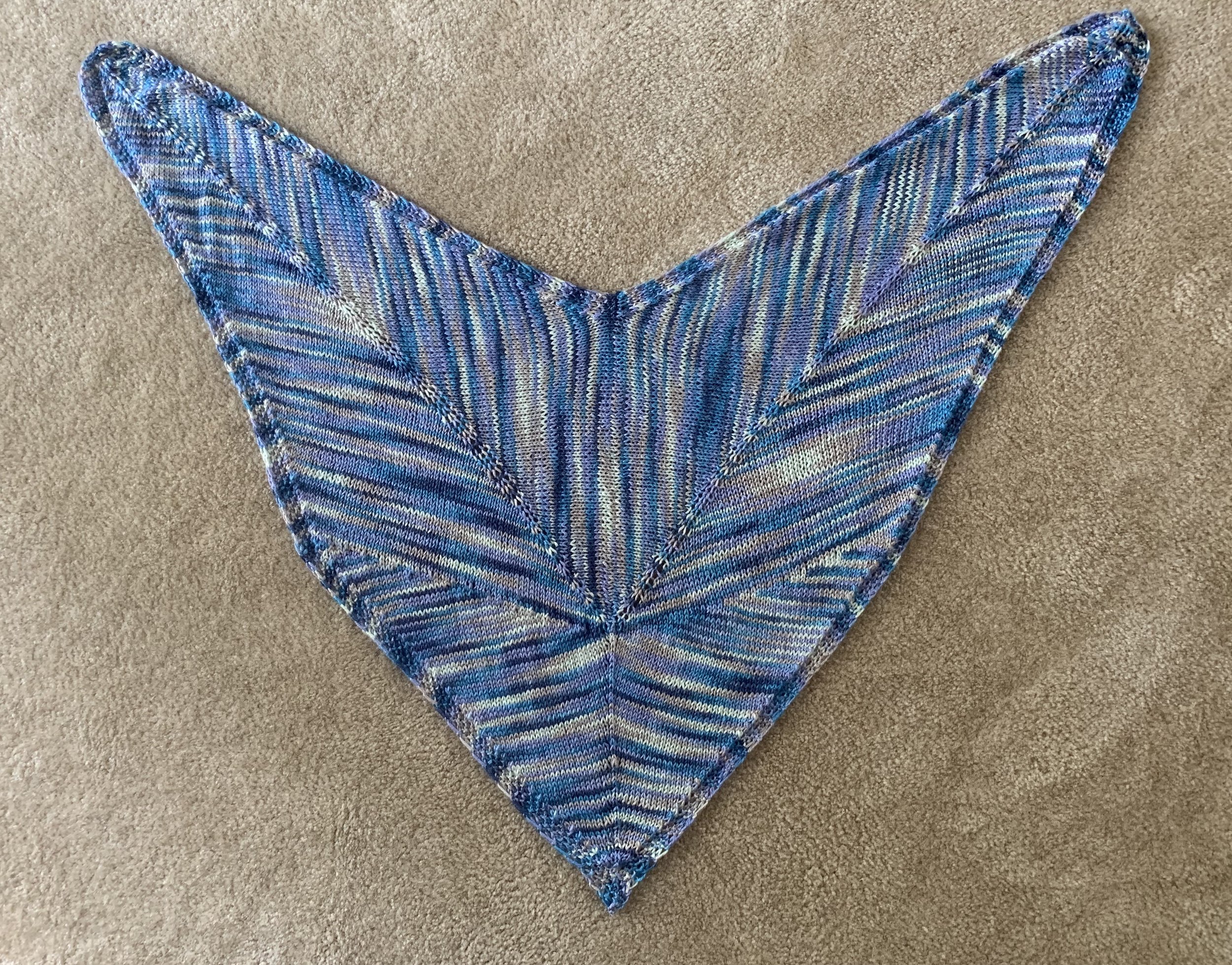





I do actually have a rough draft of the pattern written up, so if anyone is interested in knitting it, let me know!
Socks on Vacay: Unicorn Eggs and Haleakala National Park
I finished two more skeins of yarn! Same pattern and dyer as the last few, so to provide the interest this time I got my sister to take fun pictures. She aimed for the most beachy and vacationesque shots she could manage with the limited supplies on hand in my apartment.
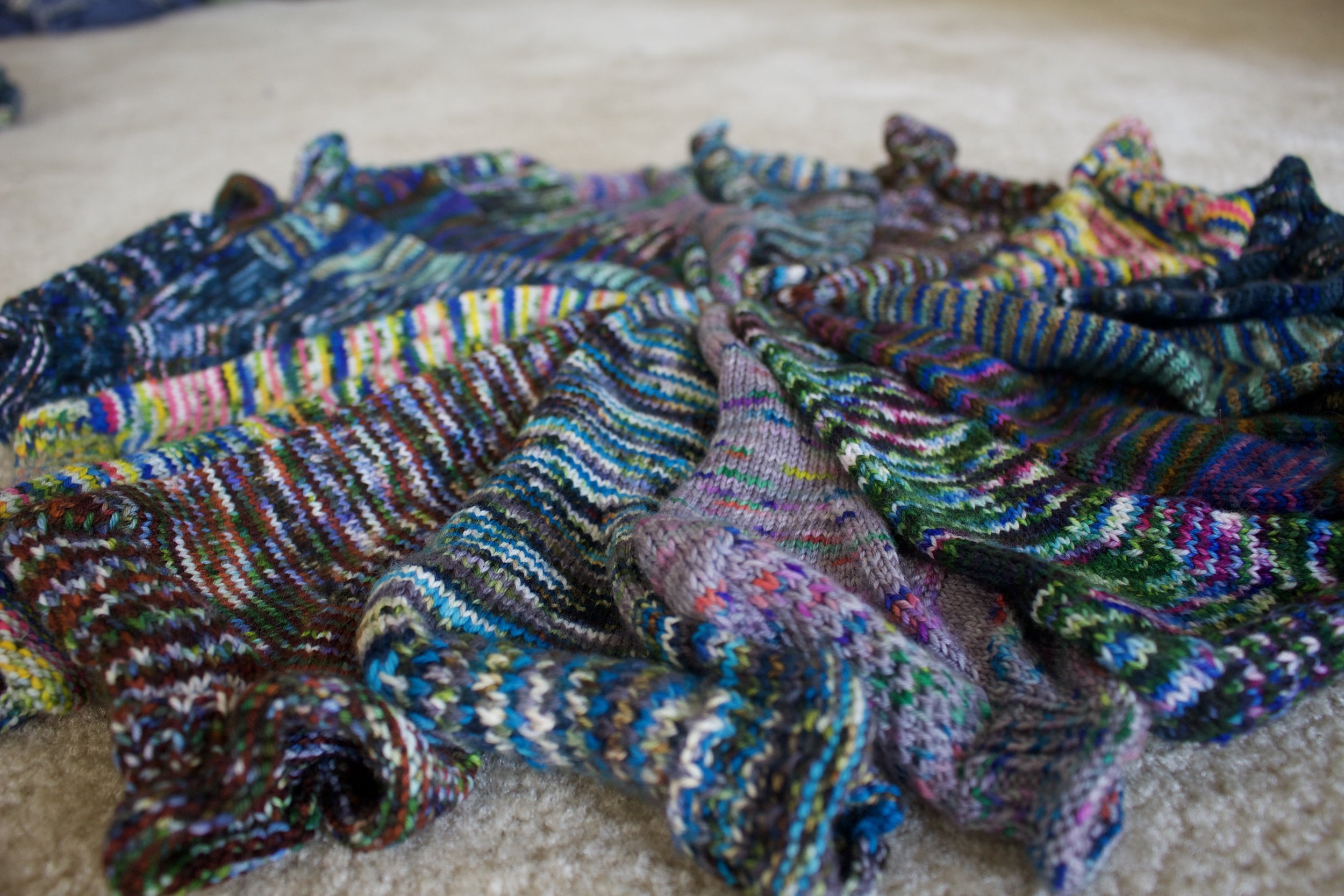
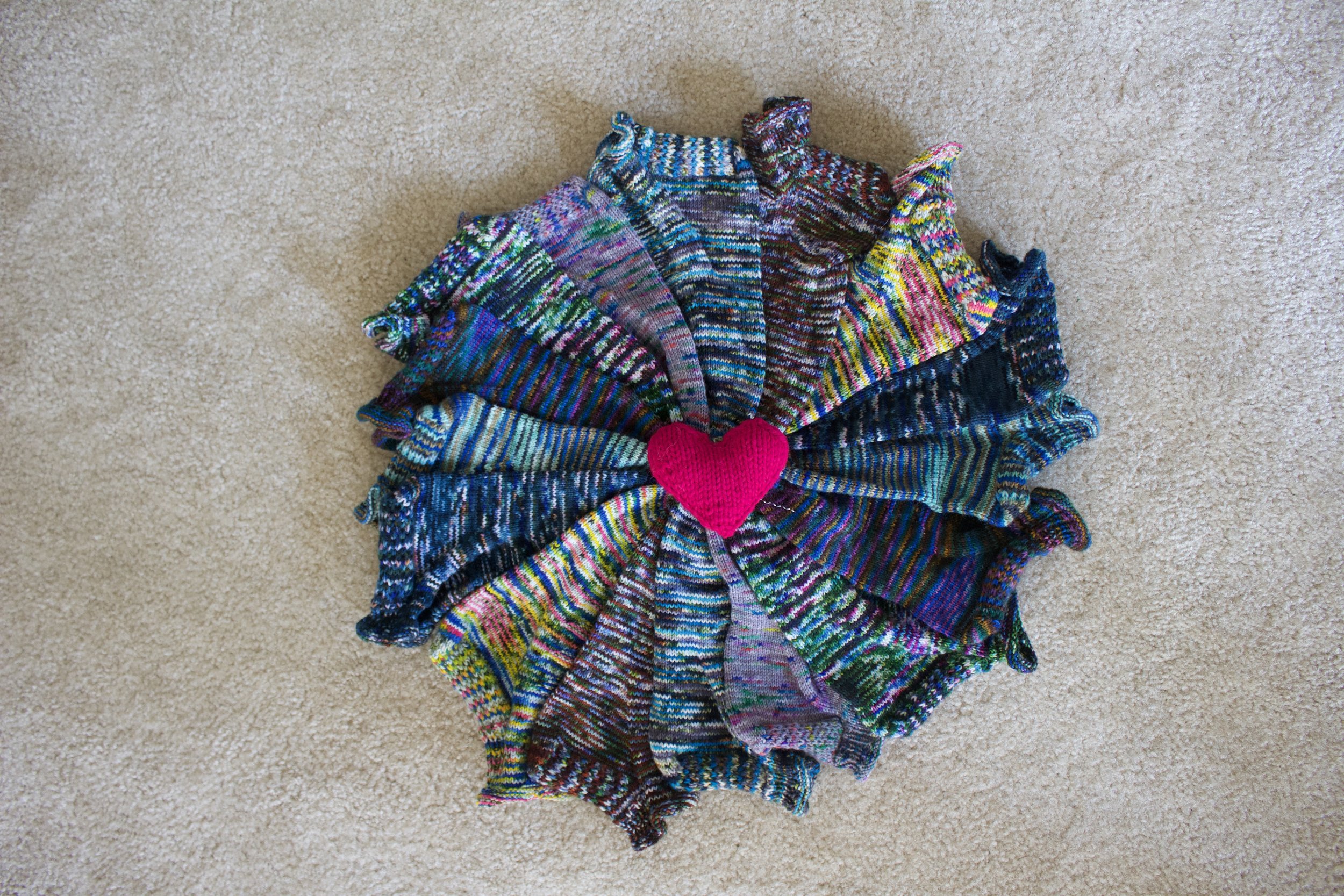

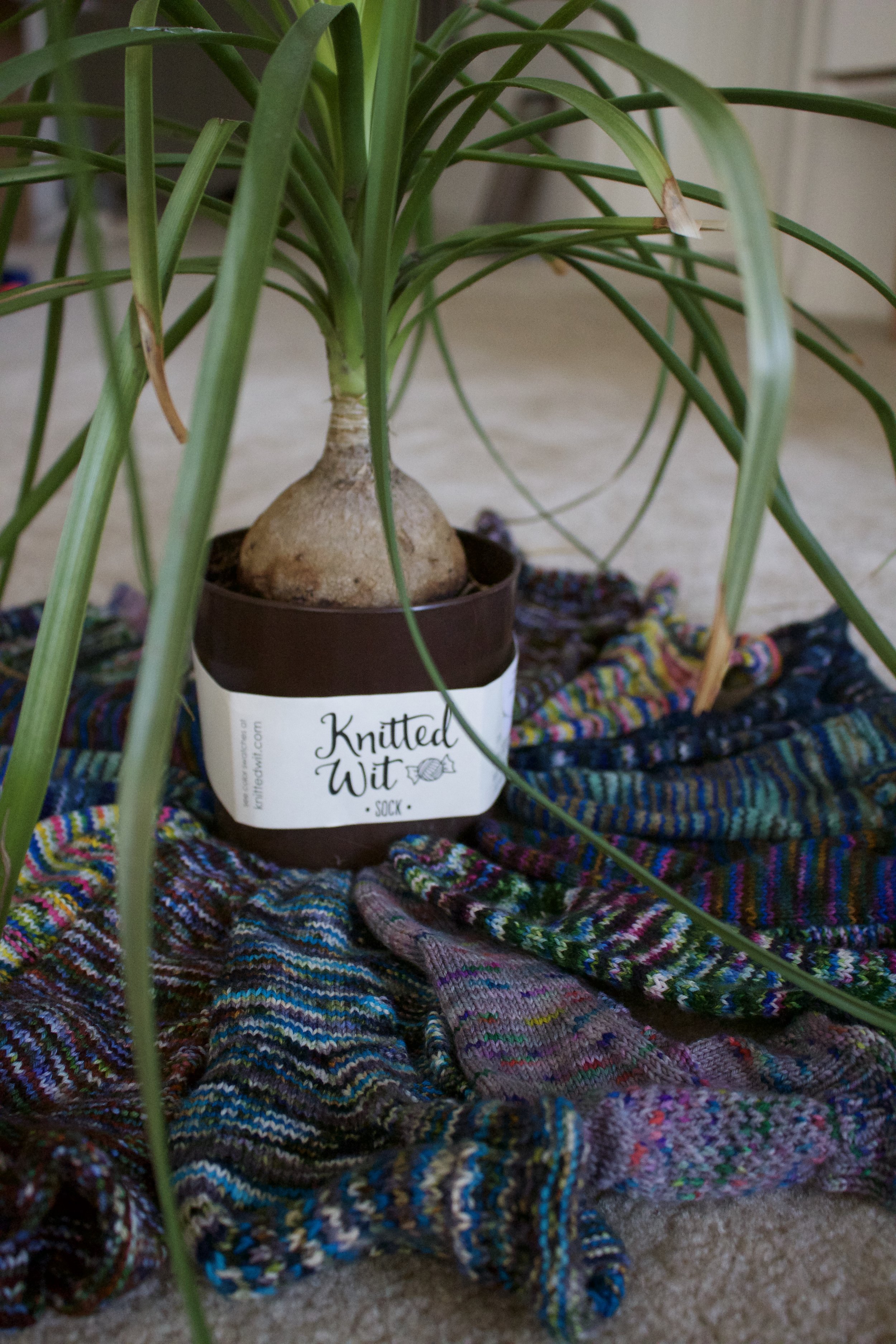
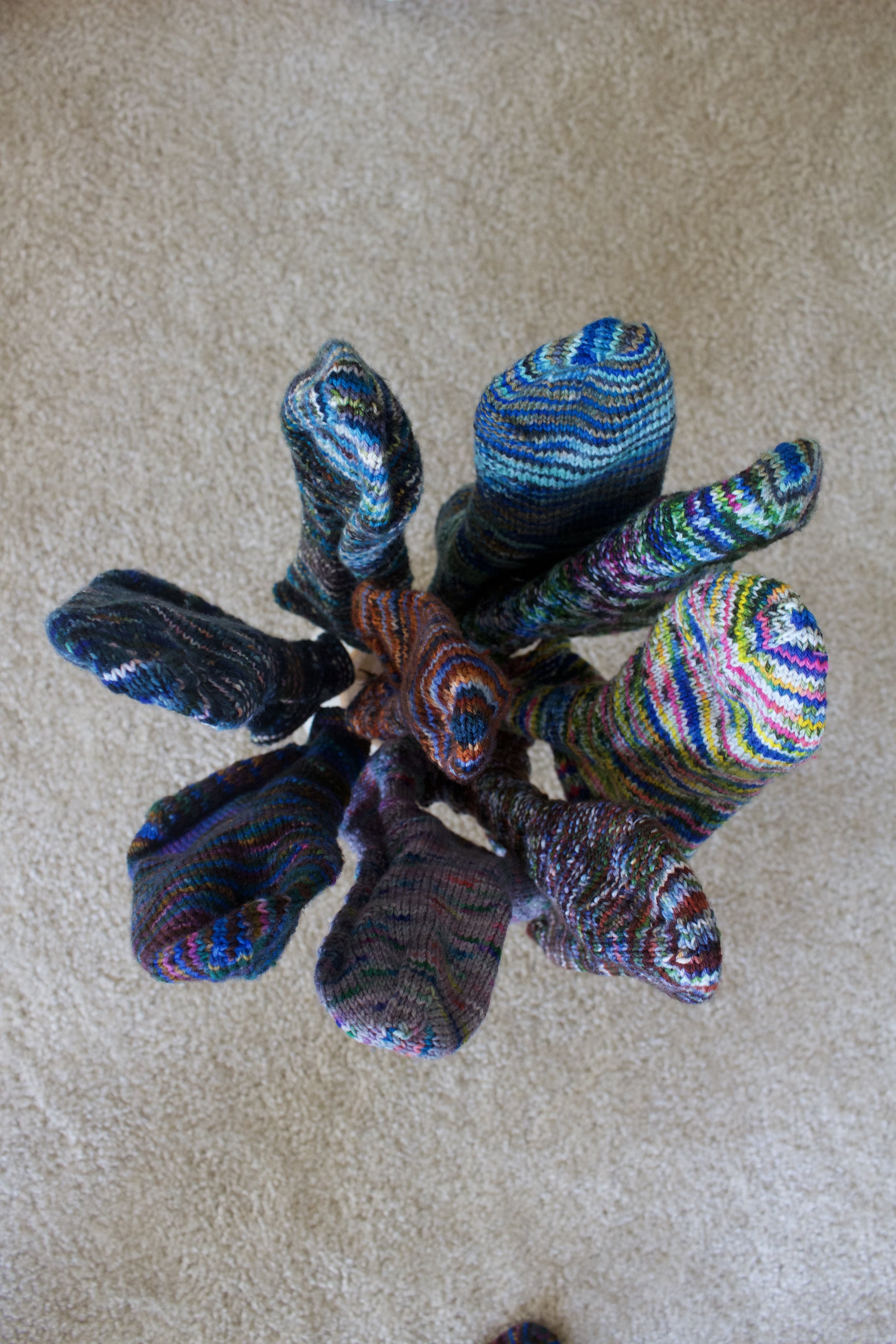
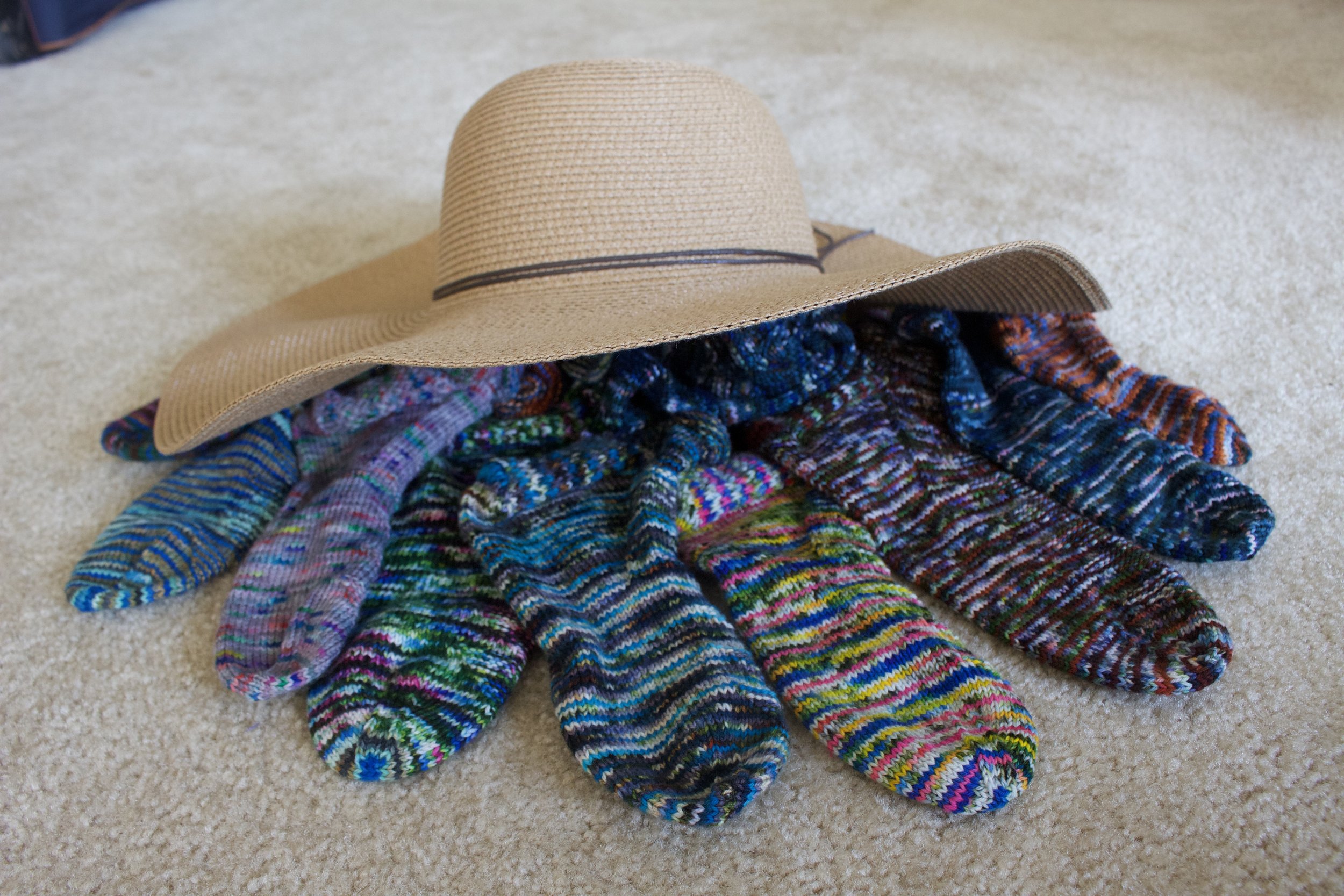

In contrast, the pictures I took of the knitting while on the plane to California don’t look anywhere near as much fun:
Socks on Vacay: Sequoia Kings
The next installment of national park yarn, in the same Short Attention Span pattern.
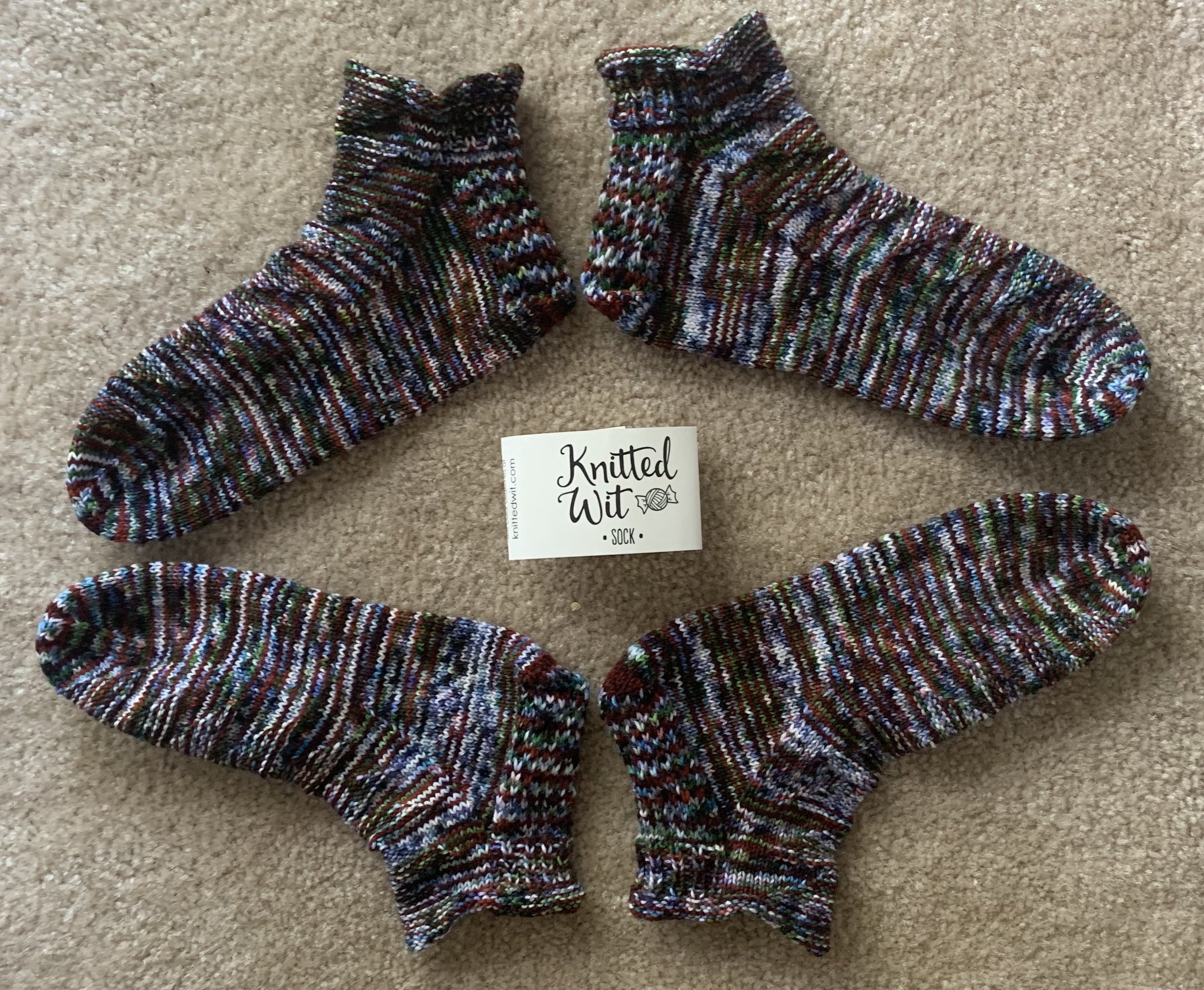


Grumpy sheep was not amused. Not even when I told him that the socks complemented his fleece very nicely! Some sheep are just hard to please.
These are pairs 46 and 47 for this year.
Socks on Vacay: Bryce Canyon
It was requested that I make a big pair of socks from this skein, so to match the big size 13 men’s socks, I made a little pair of socks to match! No yarn left over-I used a very small amount of Grand Teton yarn to finish up the toes on the tiny socks. My total leftovers from the first six skeins of Knitted Wit yarn is less than 5 grams!

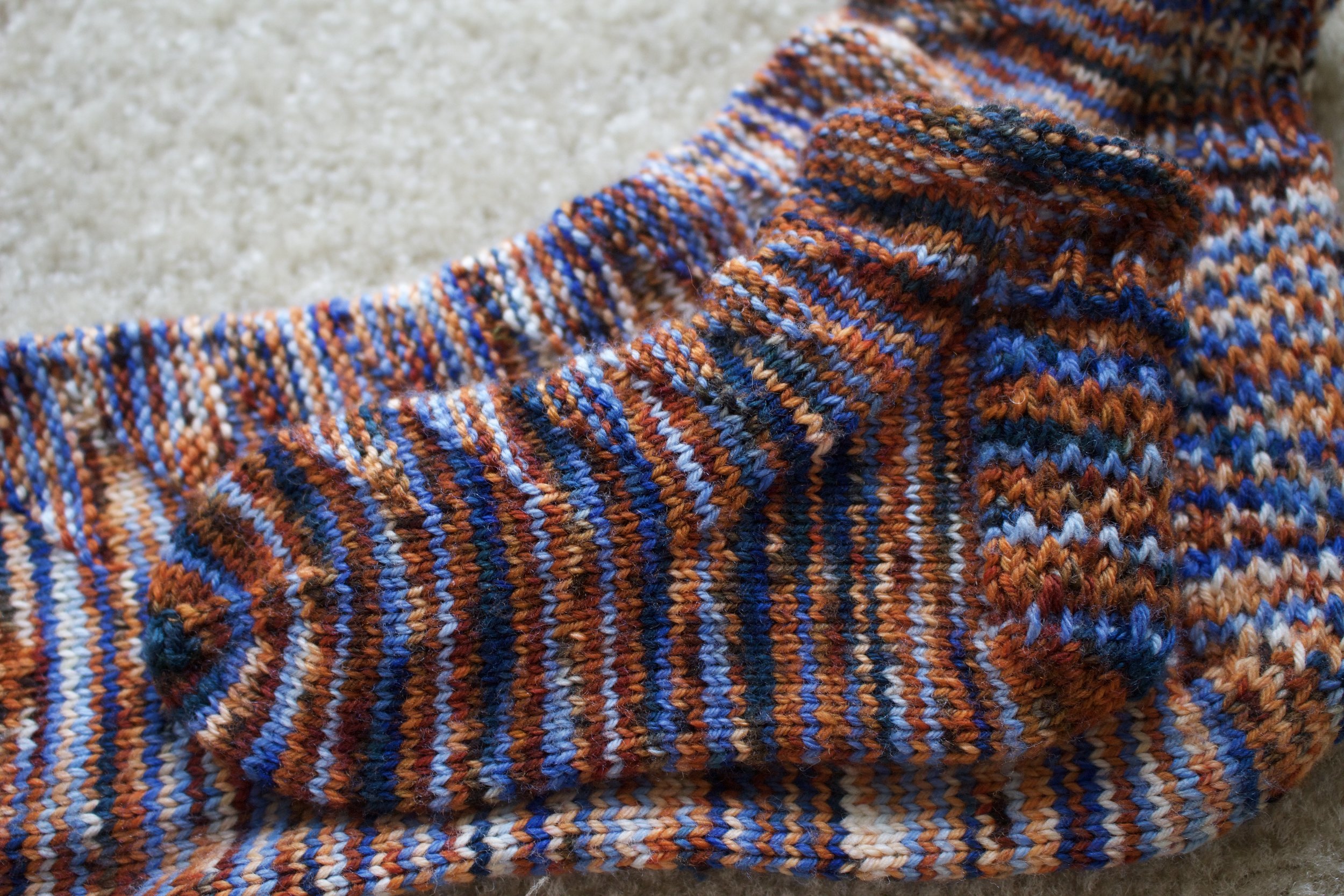







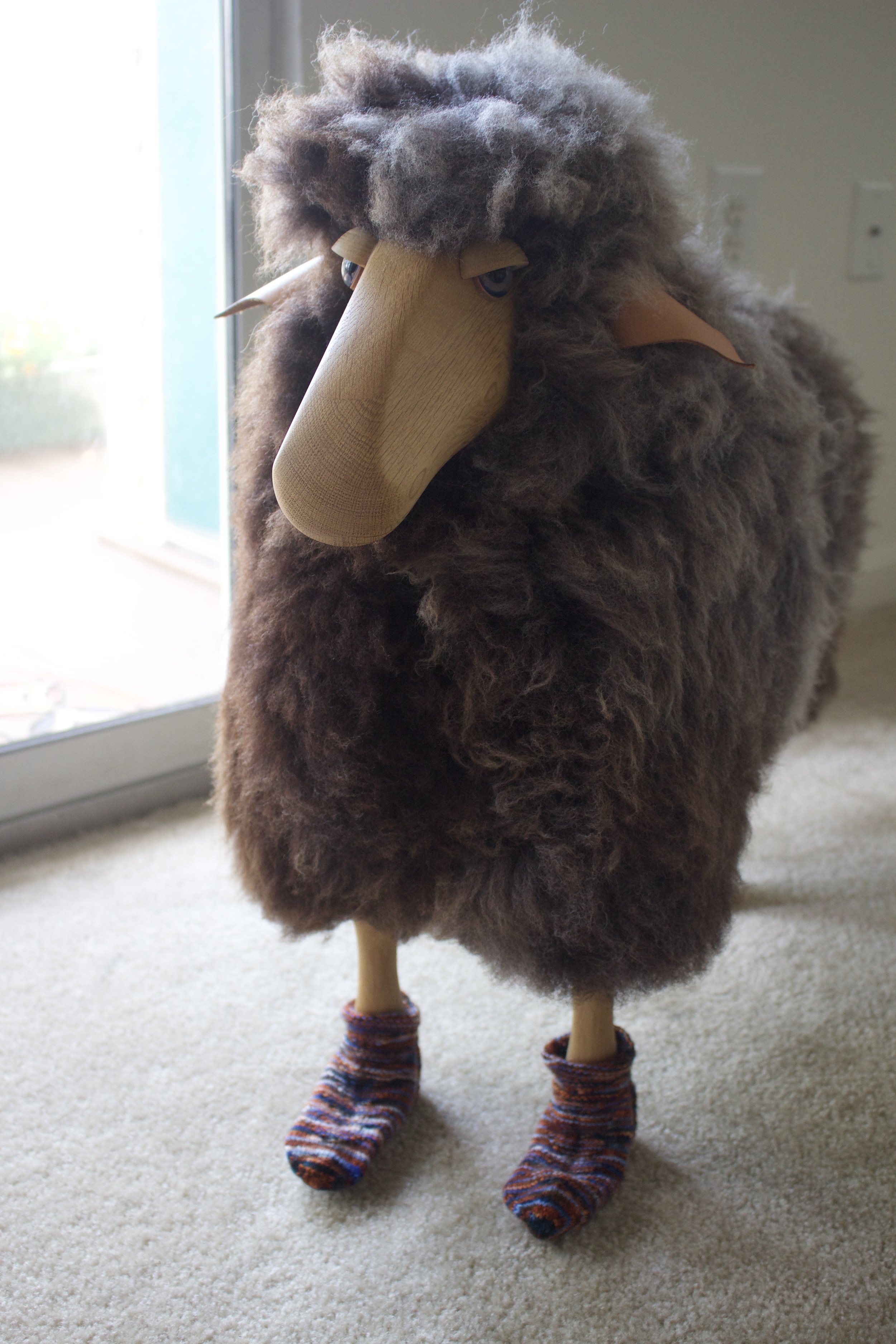

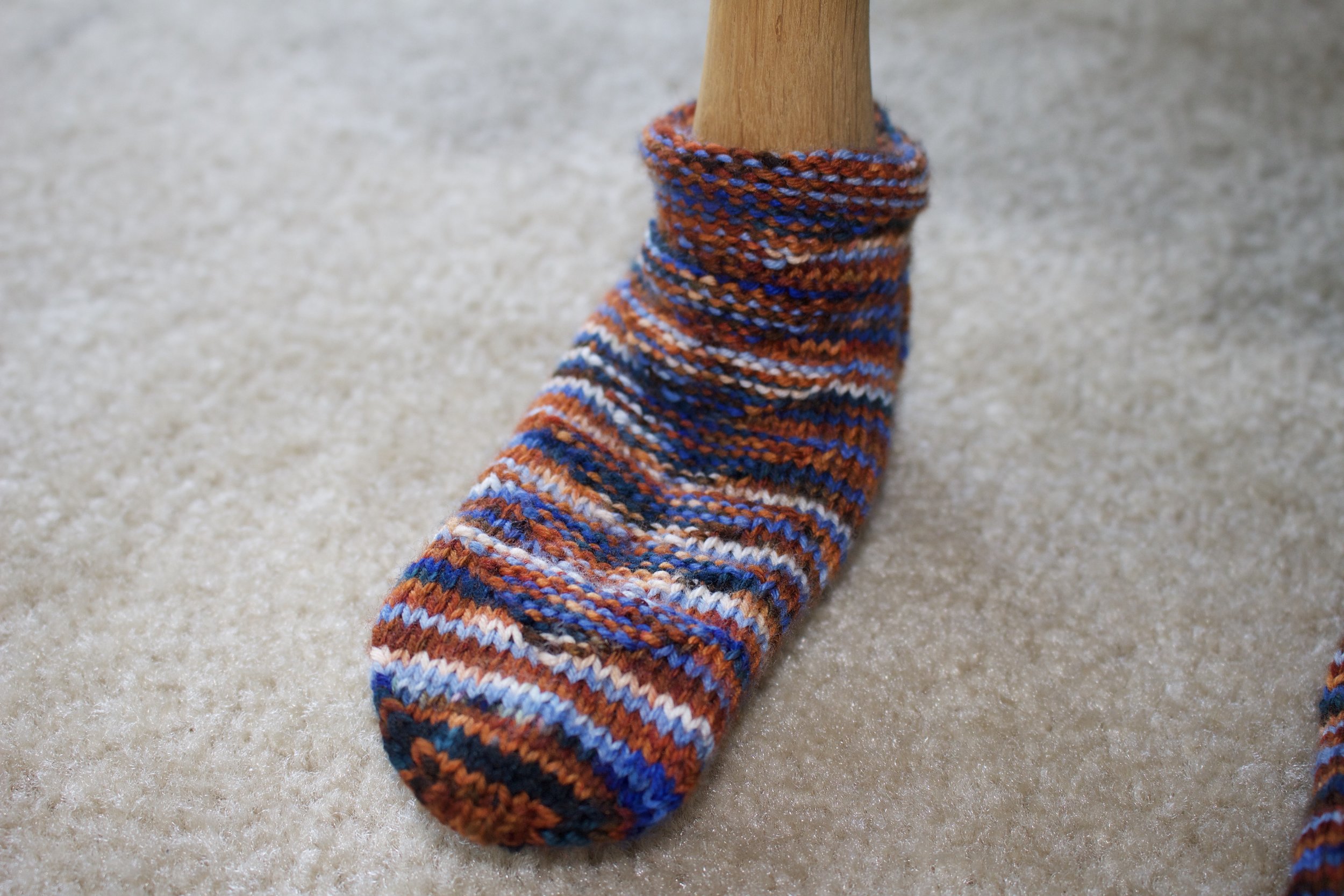
Grumpy sheep thinks that the small socks fit him much better than the size of socks I normally make him wear.
This gets me up to 12 pairs of socks on vacay, 43 pairs knit this year, and 603 pairs overall!
Socks on Vacay: Grand Tetons
Another two pairs done! I made both of these pairs the same size, and ended up with about 3 grams left over. I should be able to use it as the tips of toes on some of the future national parks yarns, if I lose at yarn chicken again!
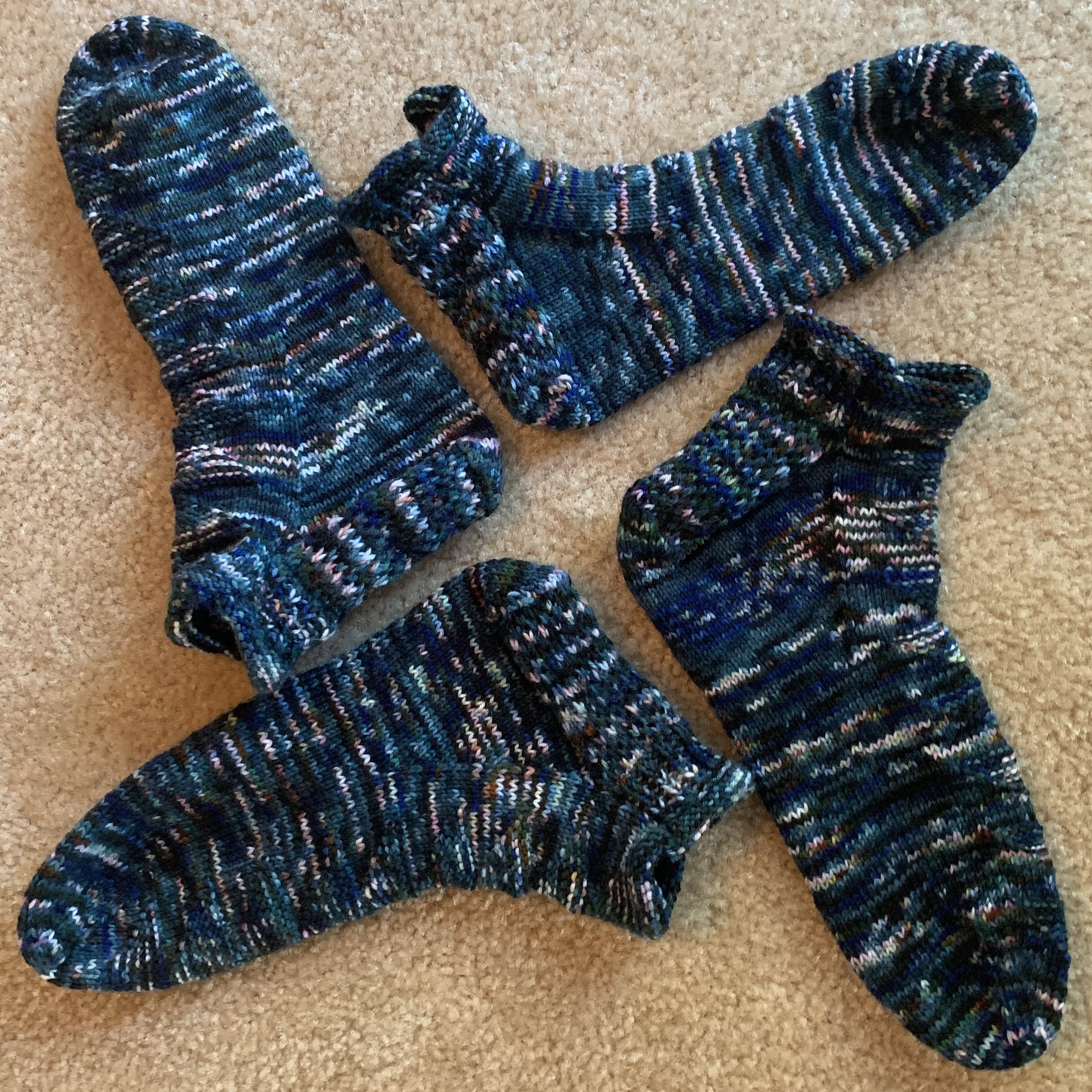

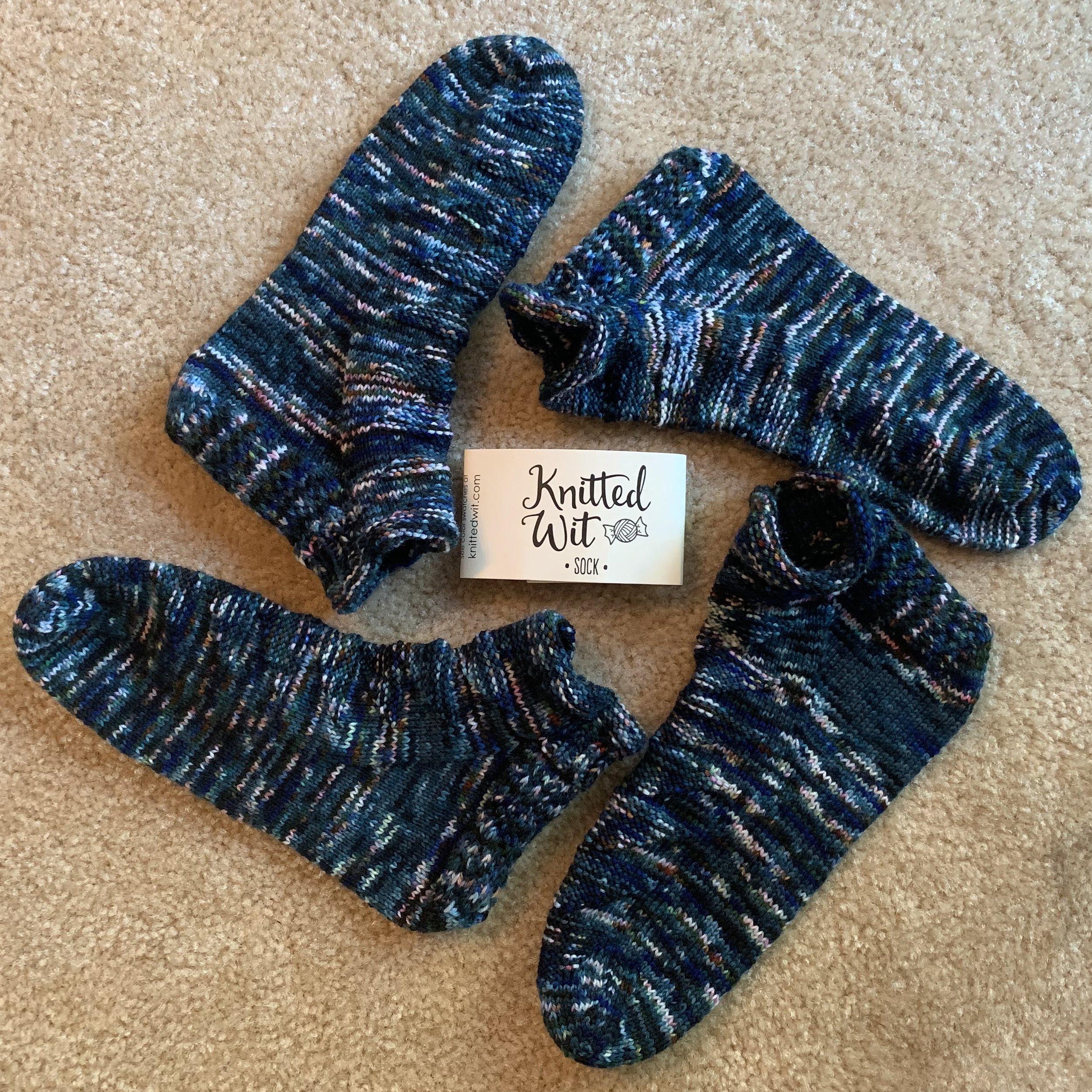
The yarn is Knitted Wit’s Grand Teton National Park inspired sock yarn, and I used Shannon Squire’s Short Attention Span pattern again…
In other news, white sheep now has a hat! Perfect to keep her from getting a sunburn this summer, should she ever go out in the sun…
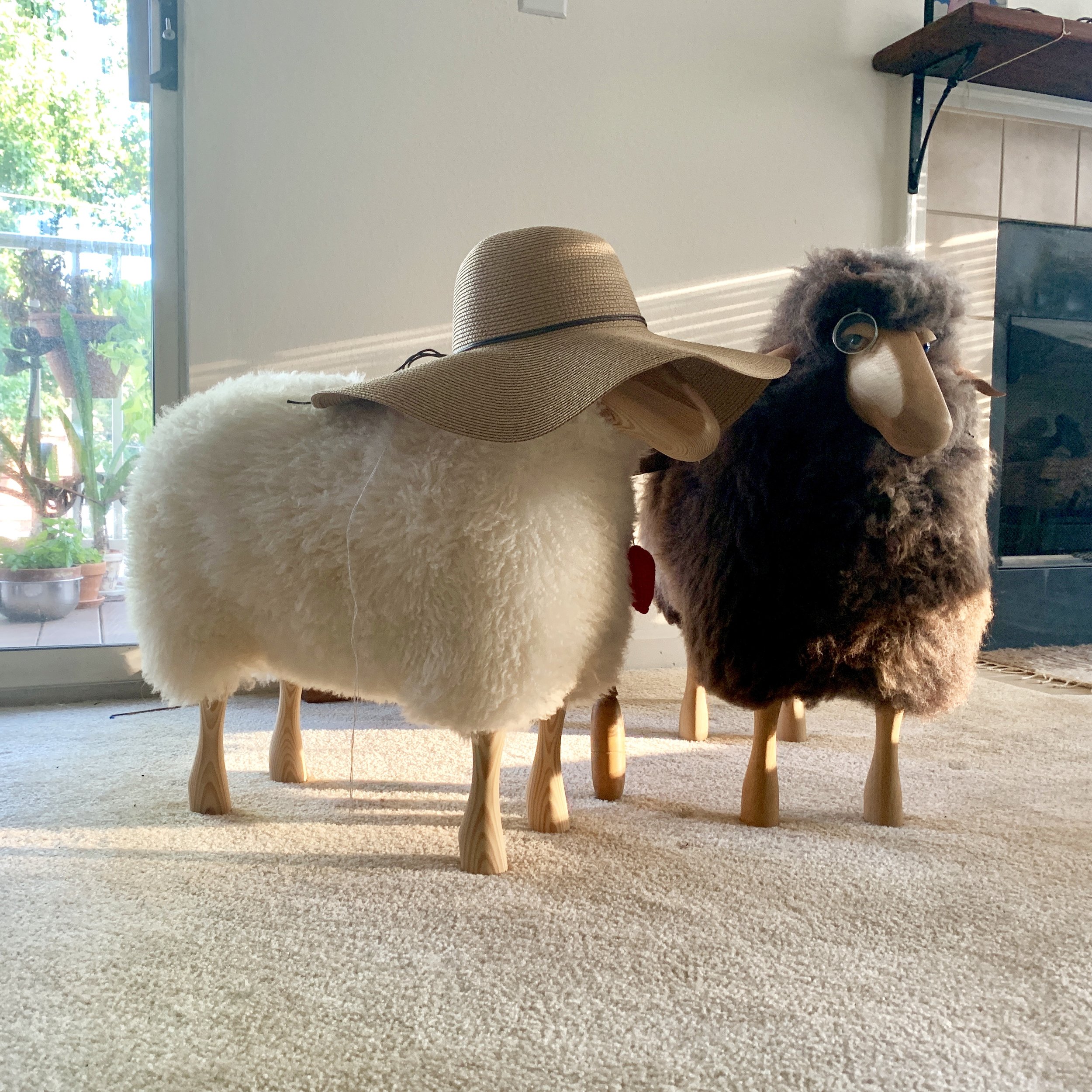
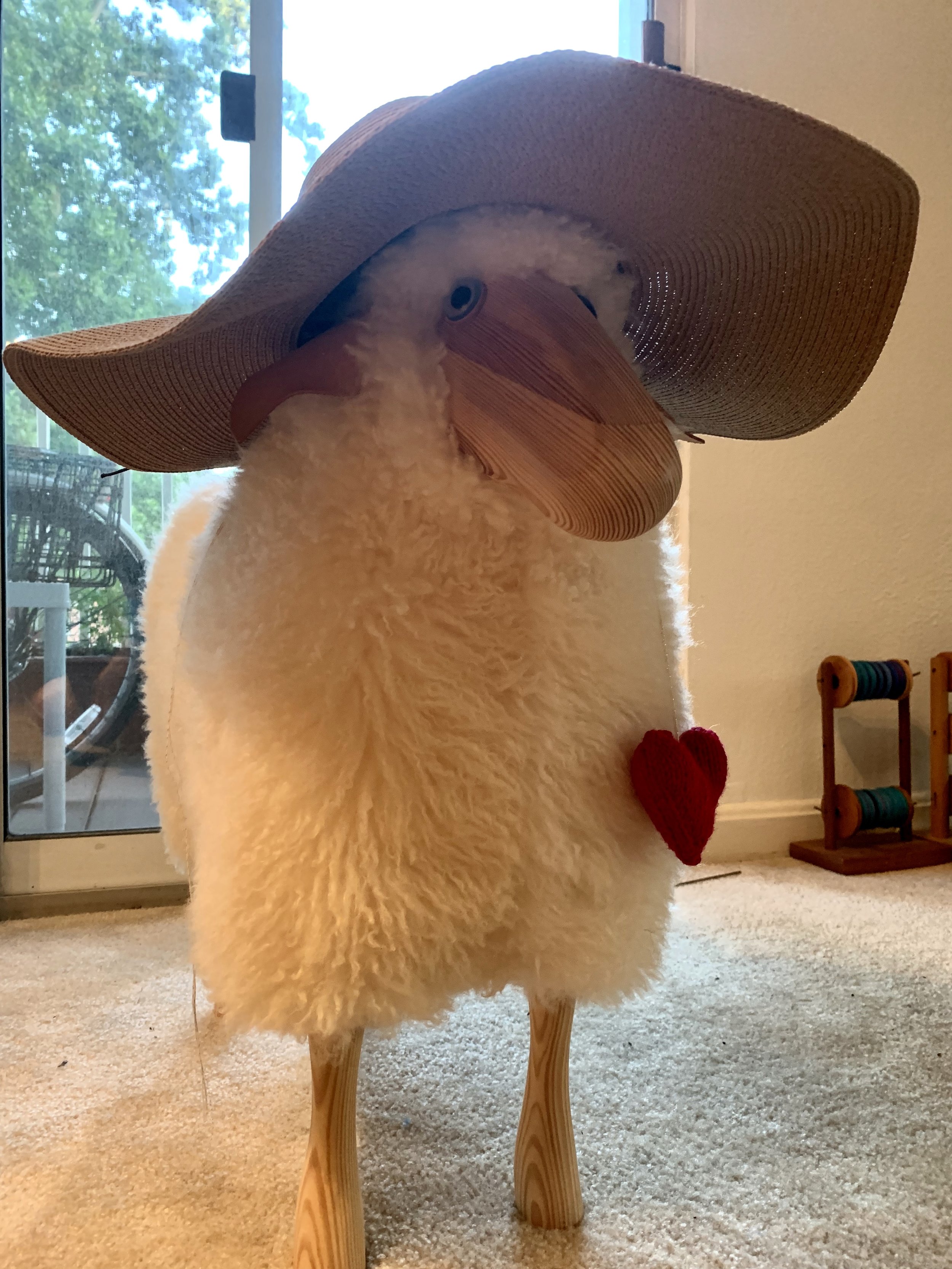
Sock fitting thoughts
There are no new socks in this post, instead there are my thoughts on making socks fit. For the summary, skip down to the last sentence.
This is my foot. I start with this because, perforce, this is the canvas I have the most ready access to, so it is what I am most used to trying to fit. I do have access to other feet, however the ones I have historically had the most access to are genetically related (my mum and sister (though not my dad, as he can’t be bothered to try on socks, since he won’t wear them anyway, and also is ticklish so doesn’t care for people handling his feet)), and thus bear a fair amount of resemblance to my own foot. In the past few years I have gained ready access to another two feet (attached to a very lovely human), however they size in at a men’s 13, which is a tiny bit bigger than a typical foot. The point is, what may work really well in fitting my feet, or those that I have really ready access to, may not work for all feet. I think the principals are sound, but that’s the disclaimer.
Second important fact is that I’m an engineer. I like the challenge of figuring out how to design a pattern to be exactly the shape of the object I’m trying to cover. I’m quite proud of the hoodie I made for my rubber duck, in particular that when it’s off is still very duck shaped. Sure knitting can stretch to cover a multitude of sins, but why force it to? If the sock is the same shape as my foot, then I don’t have any areas where it is super stretched. Stretching something takes energy, and the principle of minimum energy states that the sock would much rather find a configuration where it isn’t unevenly stretched (exact wording of that principal definitely includes socks and their desires).
Sock with leg decreases
So my goal is to make a sock where there is the same amount of ease across the whole foot. Since I knit top down, we’ll start with the leg. This can easily be modeled as a tube, so that’s fairly straightforward. If we’re being fancy, we can even decrease the width of the tube as we get down towards the foot. In an ideal world, I cast on exactly the number of stitches that fit around the leg at the top of the sock. Then I knit down the leg, decreasing as I go, until I reach the foot. While I sometimes actually do this, I will more often either use ribbing to keep the amount of ease constant, or (such as with patterned mosaics, where decreasing would mess up the pattern) I just knit a tube and claim that my leg didn’t change too much in diameter anyway (which is not valid on my leg, but may be on yours?). The one trick is that you should never decrease to the point where it will not fit over your heel, otherwise you won’t be able to get it on (I suppose you could put buttons, or some other closing mechanism, in it, but that would be a very unusual sock).
The main thing that I do differently than many sock patterns is where I end the cuff. I believe that the foot of the sock starts where the diameter of that leg tube needs to start increasing, i.e. the black line in the picture. This means that my standard heel flap is at least 3 inches long. For those size 13 men’s feet, I’ve been known to pick up 28 stitches along each edge of my heel flap. This is the primary reason that I typically do a heel flap. Afterthought heels, short row heels and the like tend to make the heel region have a square shape on this side view of my foot. If we line a square (the purple region) up with that black line, then extend it down to the bottom of my foot, then almost all of that region between the green and black lines is actually one giant heel. Maybe it’s just my foot where this box covers such a large area, but for me any time I’ve knit a short row or afterthought heel (and to be fair, that isn’t all that many times) it’s been very tight across the top of my foot, between those green and black lines. I’m sure this is all very fixable, but I haven’t yet invested the effort in figuring out how to get techniques that aren’t a heel flap to fit my foot.
The width of the heel flap is then one of the factors in how long the decreases will last. With a wider heel flap, more of the stitches are decreased at a faster rate in turning the heel. The math implies that if the foot takes a longer time to taper (green line shifted towards the toe), then perhaps a narrower heel flap is better. This is, of course, assuming that we do two decreases every other round, as is typical. I often decide the width of my heel flap based on how it makes sense with the pattern, and don’t normally give too much thought to this variable. For my cabled clock socks I will use a narrower heel flap, but I balance that with faster decreases during the clocks section.
ssk decreases making an angle
bottom decrease heel
There are multiple ways to do the decreases after the heel. Having the decreases start from where the black and blue lines meet allows the knitting to take on a bit of a zig-zag shape, just by the nature of the decreases. Alternatively, decreasing at the bottom of the sock separates off the ball of the heel. Both create a sock that looks like a foot, and for me, both seem to fit equally well. I find that line of decreases helpful in locating the top and the bottom of the sock when it’s toe time, but when I have a mosaic pattern that I want to go all around the foot, the decreases at the bottom don’t interfere with the pattern. They also make a bit of an arch shape in the sock, which could be a plus?
Once we’re in the main body of the foot, I am back to knitting a tube. To be true to my principals I might want to do some ribbing in the arch, for feet with high arches at least, to help keep the sock snug in that region. I have a fairly standard, good quality arch though, and have never felt that my socks gape there, and thus don’t bother. I think having the decreases last longer than many patterns (due to the longer heel flap) helps with this too. For the foot, a tube seems to work fairly well because while my foot may be decreasing in height, it also increases in width, so that there really isn’t much change in circumference from the green line (approx. 9.5 inches) to the biggest bit right before the toes (approx. 9 inches, so a 5% change, around 4 stitches? My ankle was 8.5 inches, for reference.).
My toe is standard. I’m not super worried about it, and I don’t mind making the sock conform to my toes. To make the socks look exactly like my feet I should make asymmetrical socks, but I can’t be bothered. I’m much more concerned about fitting that heel. I guess that’s the point of all of this, really-making a nice long heel flap allows me to use a minimal number of stitches in the leg and foot, creating socks that are snug (but not tight) throughout.
Socks on Vacay: Great Falls
Another set of socks made from yarn by Knitted Wit, in the Short Attention Span pattern by Shannon Squire. This time I won at yarn chicken!
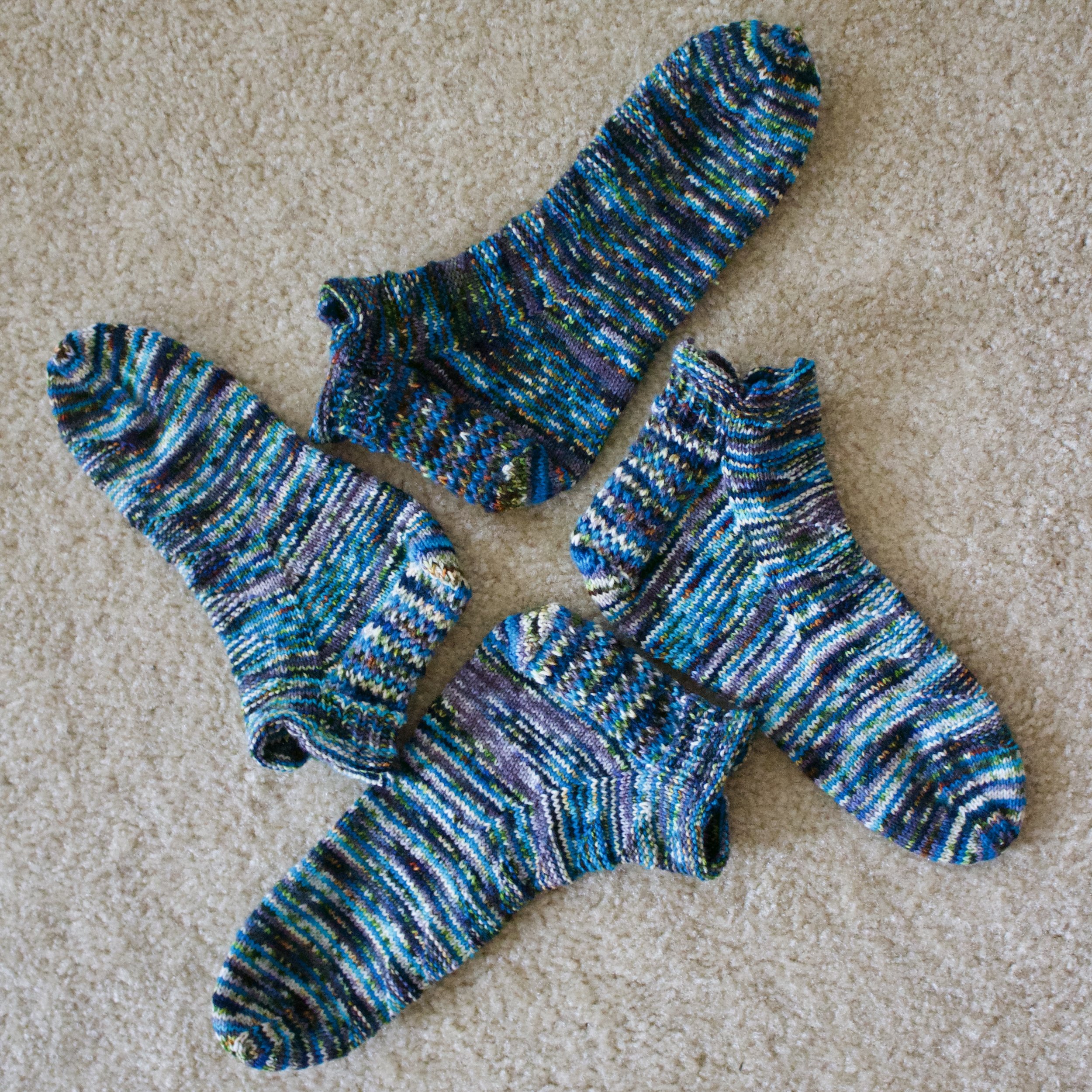

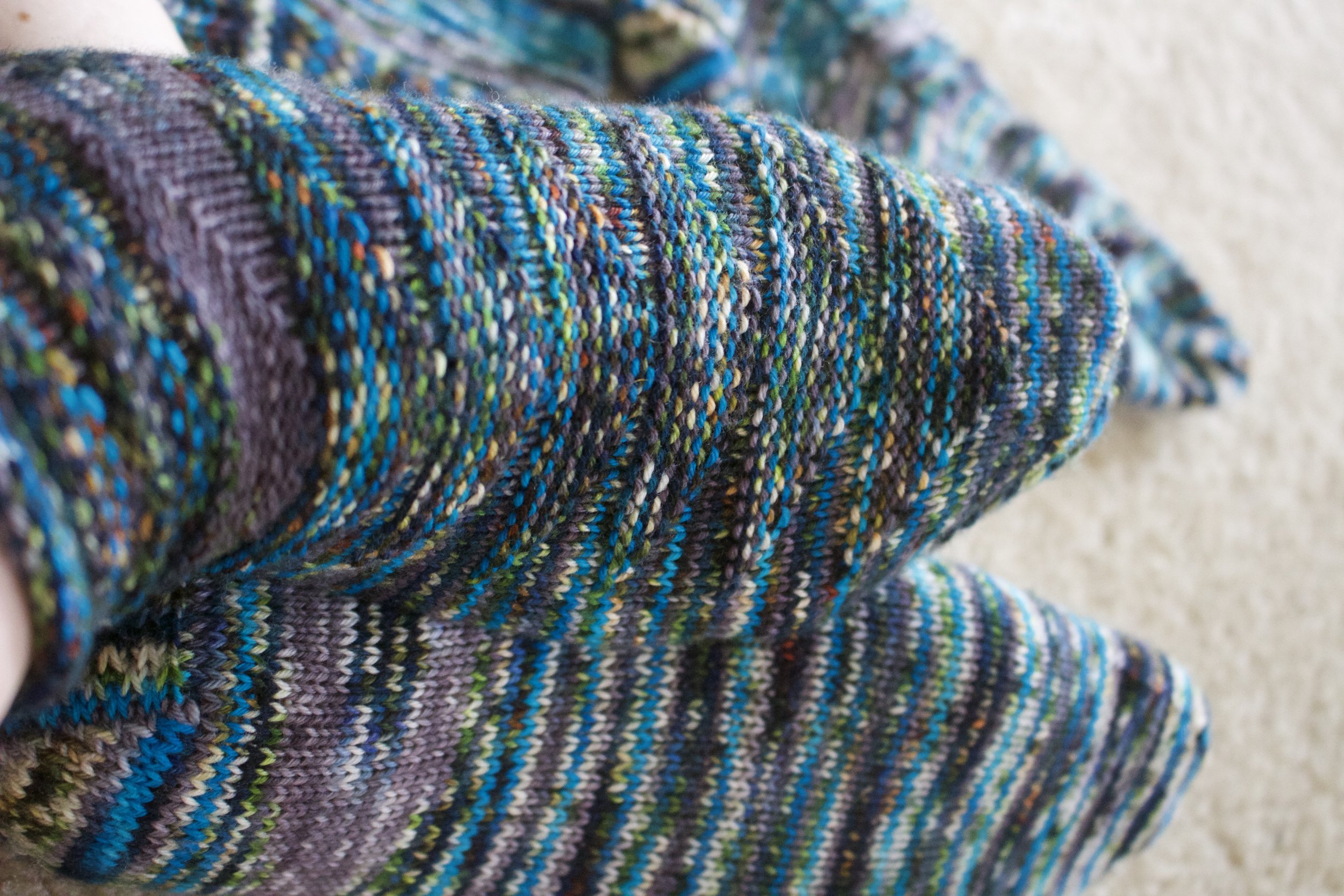
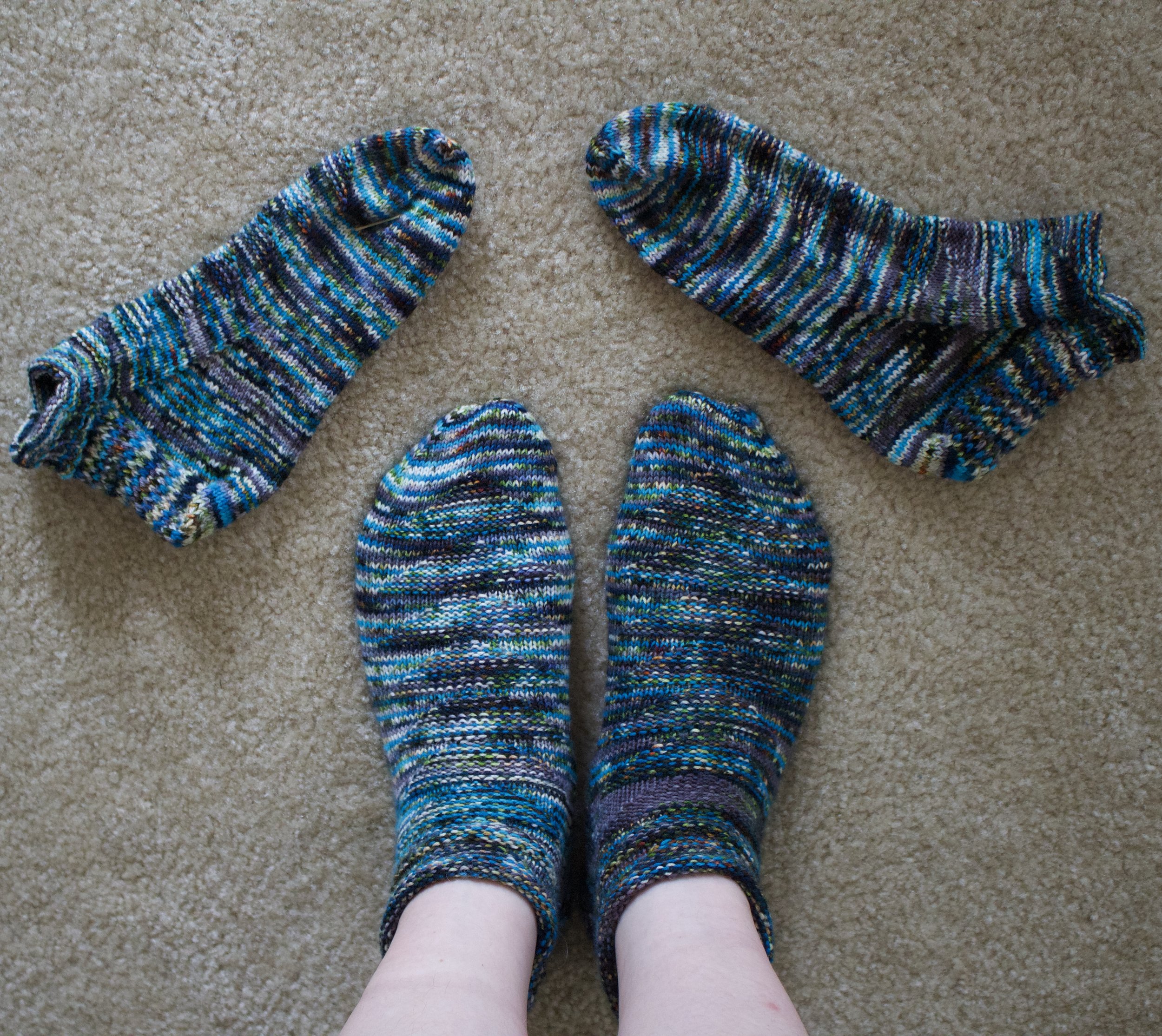
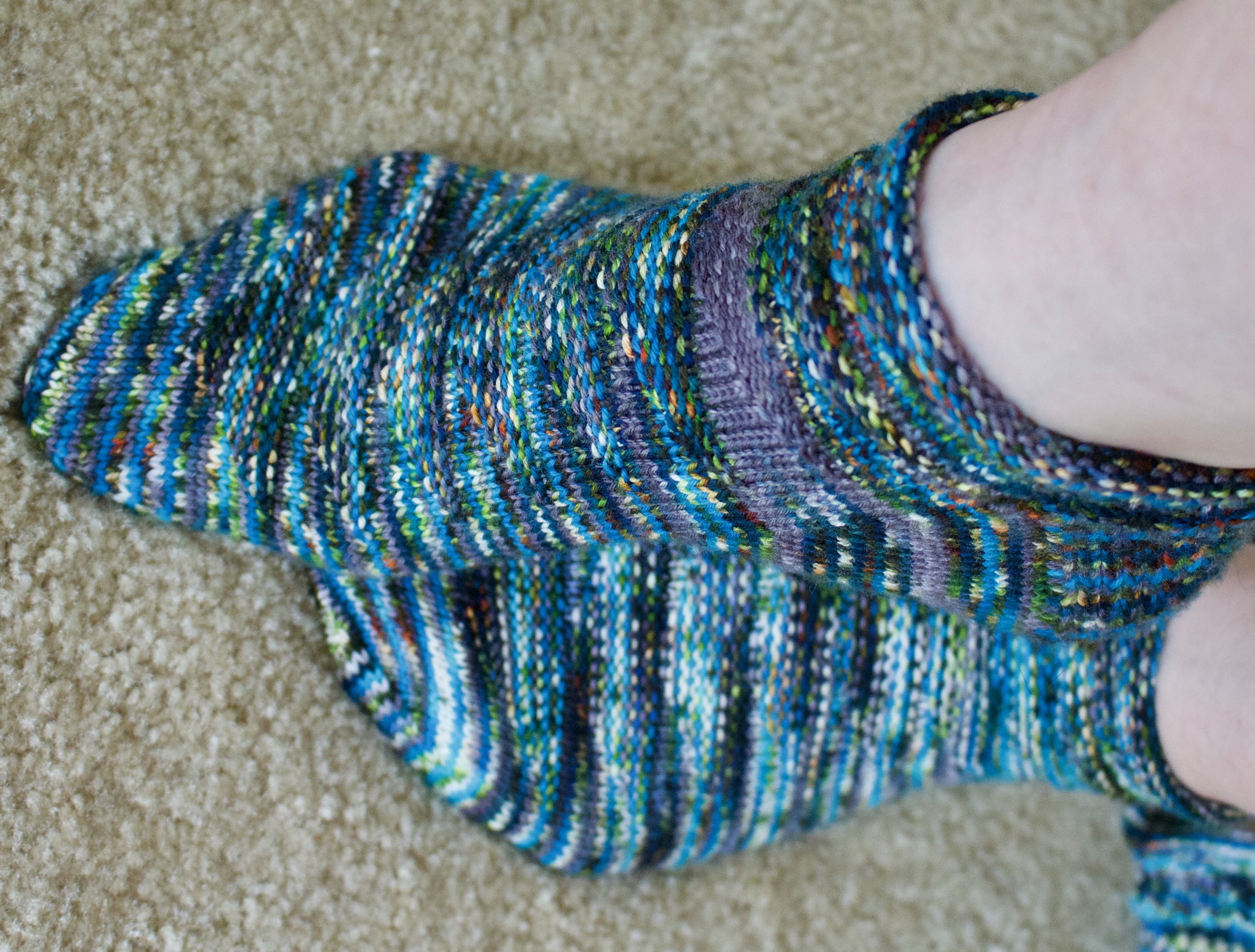



I’ve now fully adapted the pattern-I typically cast on the number of stitches for the smallest size, but assign more than half of them to the top of the sock, knit a narrow heel flap that’s the longest length specified in the pattern, and decrease down after the heel to either 4 or 8 more stitches than I cast on. I can typically get both a pair that is women’s size 7 and one that’s size 10 out of the same skein.
Mosaic 42: Marigold ribbons
I’ve had these socks on the needles for months now, but I keep getting distracted. I miss the mosaic patterns! These ones are the same yarns as the zig-zags: the black is opal sock yarn, and the yellow is Copper Corgi’s Savannah Sock in the color ‘wearing and tearing’. I think that color is exactly the color of my marigolds! ‘Ribbons’ is the name that Barbara Walker gave the pattern. For anyone with her book at home, be aware that this pattern has a mistake in the book-the right most square of row 15 should be black, not white. This is the first mistake I’ve found!
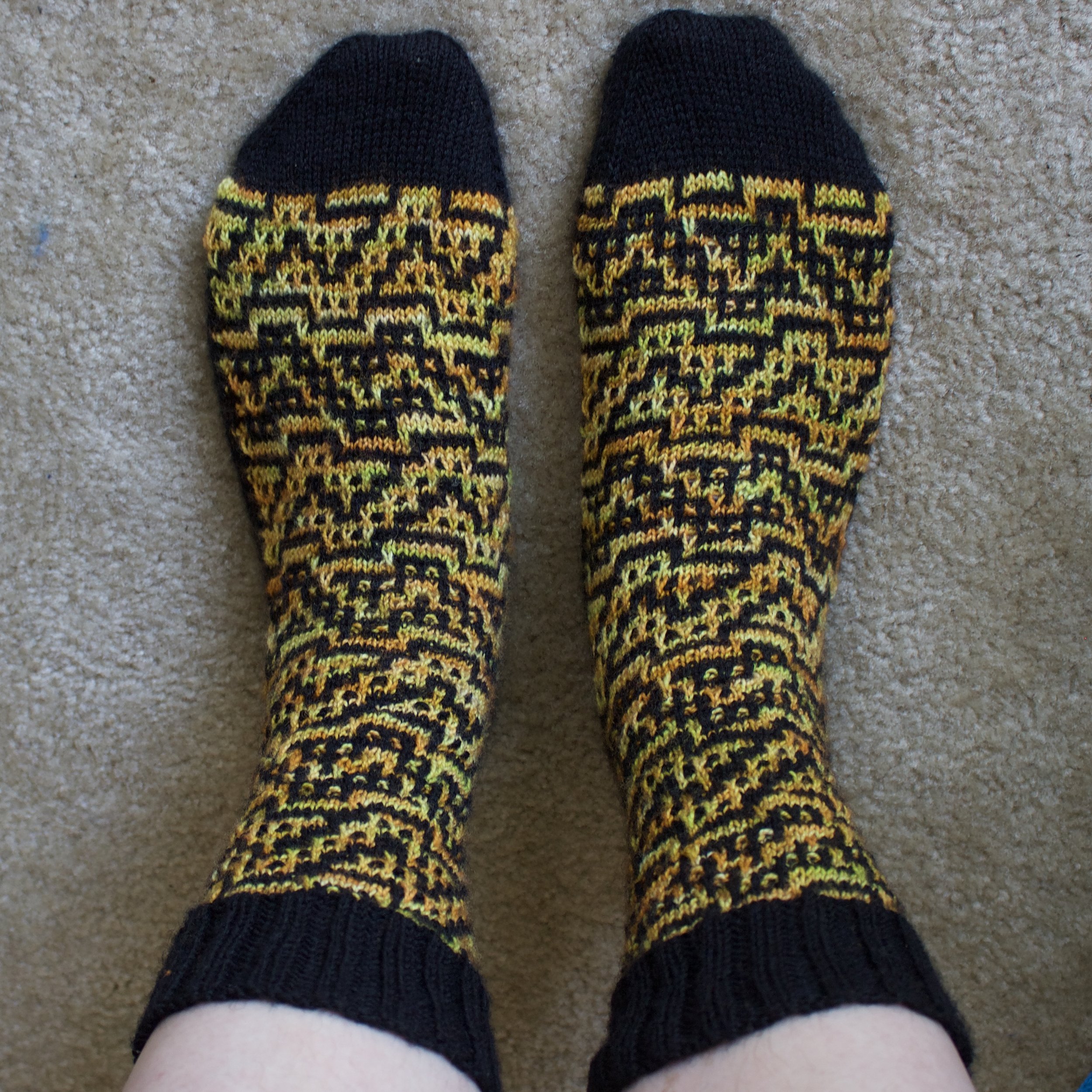
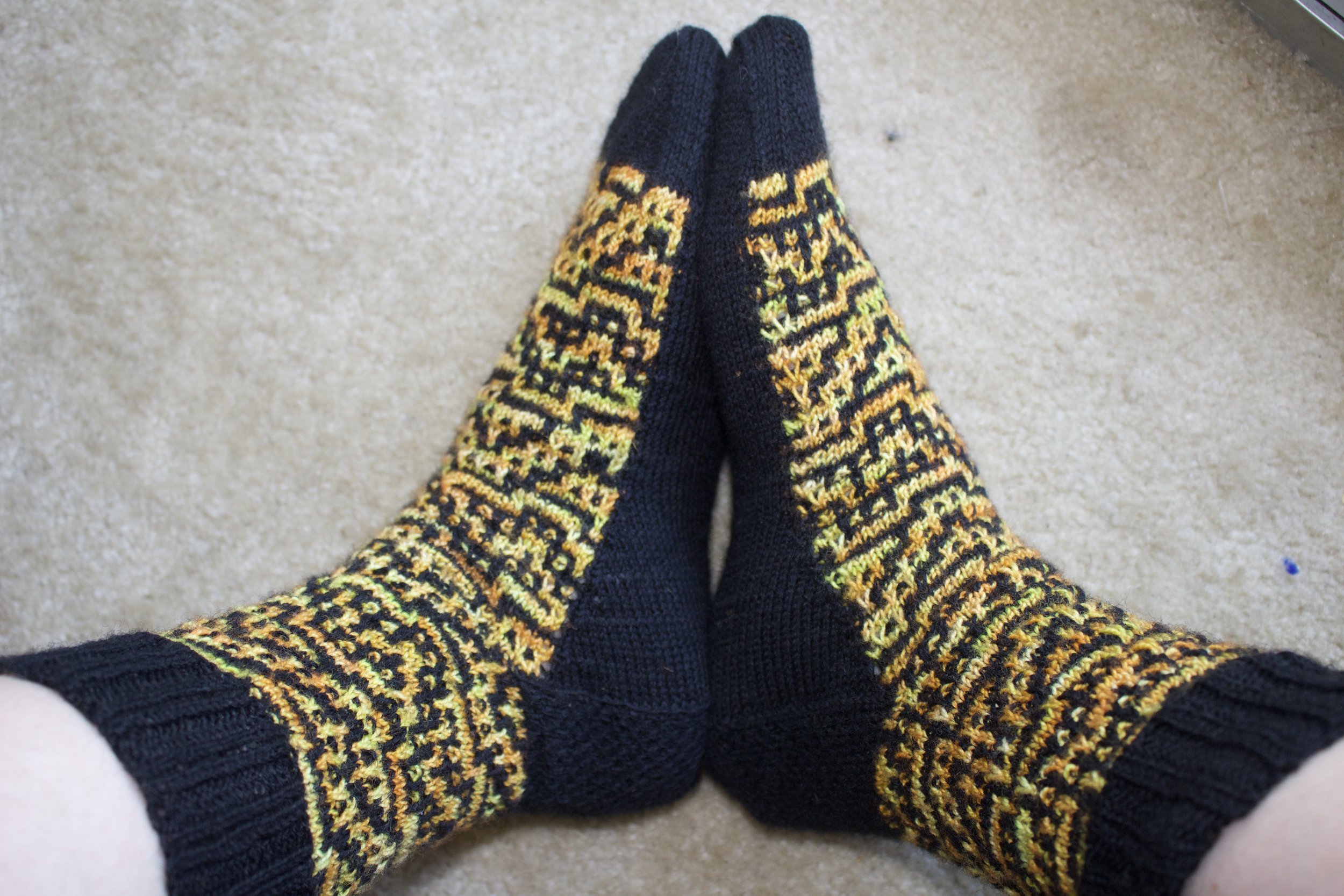

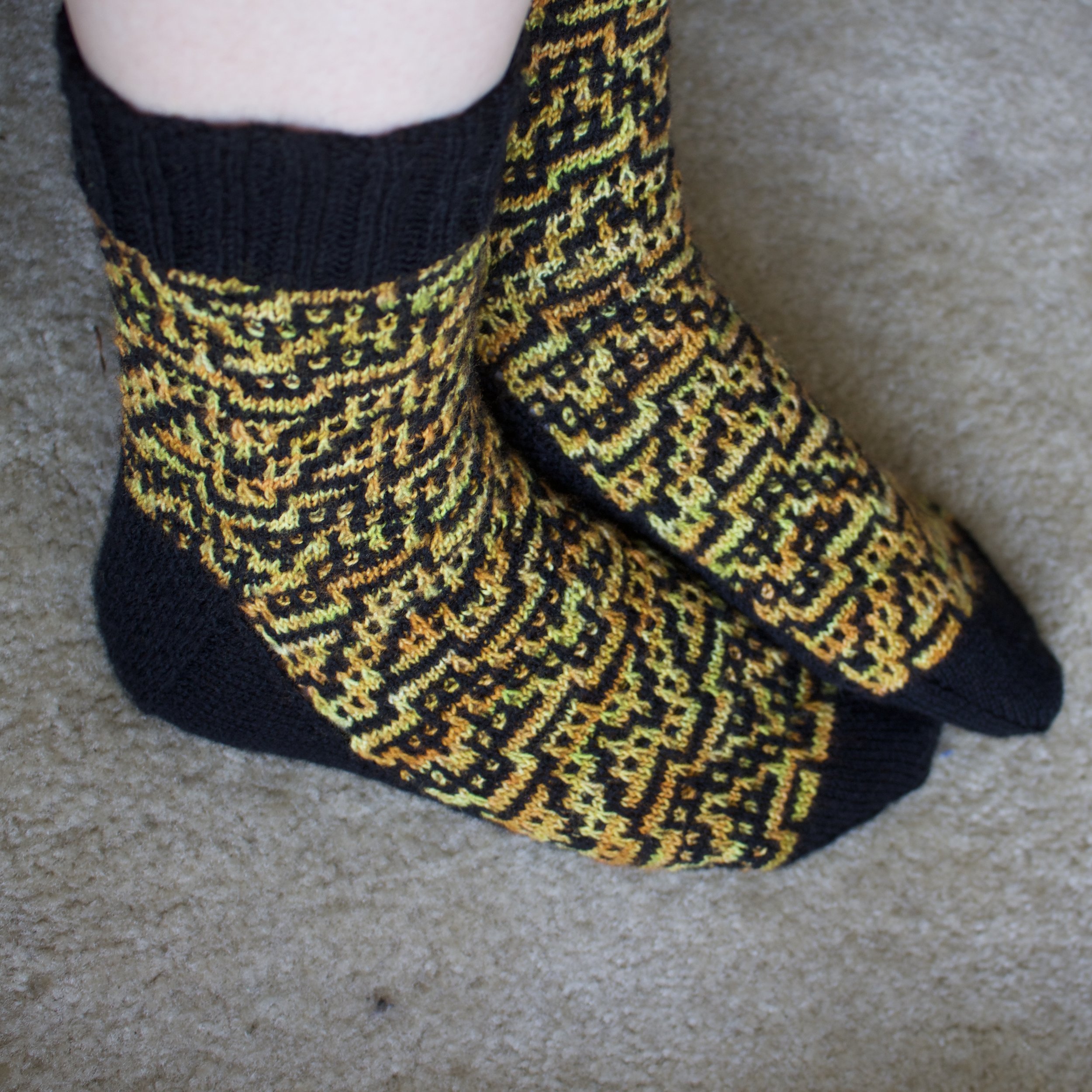
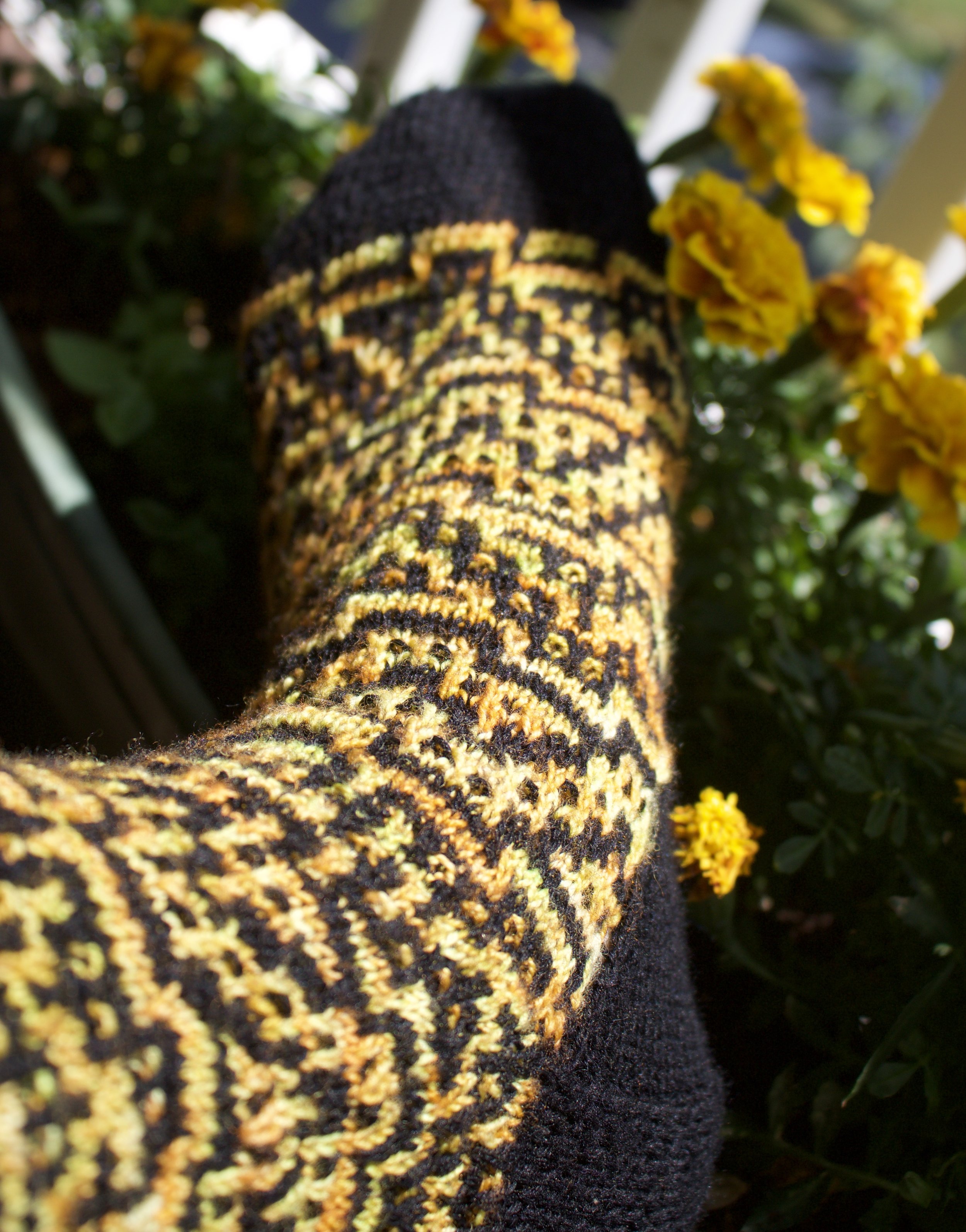
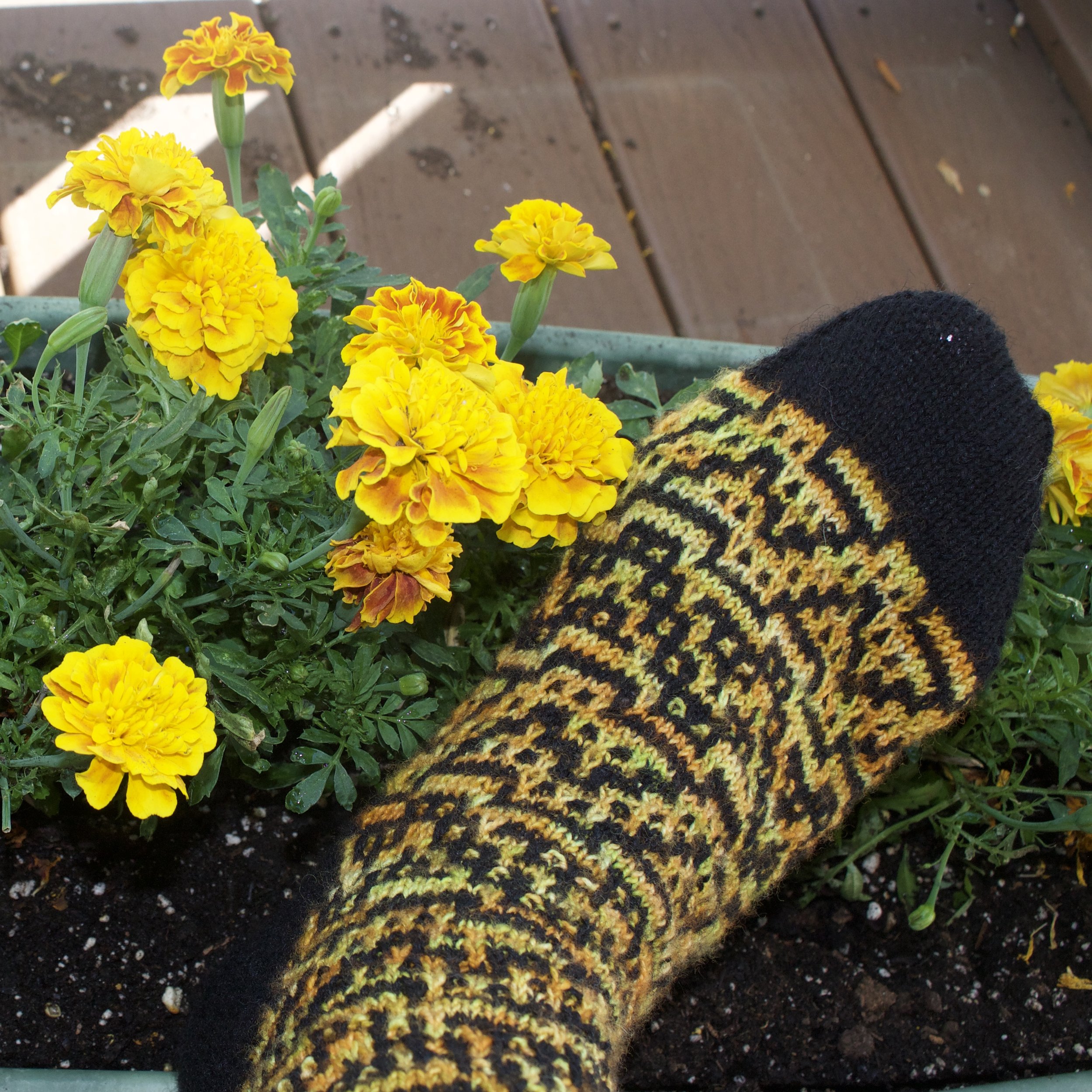
This is my 39th pair of socks for the year (599 overall), and this Tuesday (yesterday) is the end of the 26th week, so I’m averaging 1.5 pairs per week! The little anklets from socks on vacay are helping my sock count a lot.
Socks on Vacay: Wrangell-St. Elias
Another two pairs of socks done! I stuck with Shannon’s pattern Short Attention Span, and the yarn this time is Knitted Wit’s Wrangell-St. Elias National Park yarn. I can’t show you both socks at once, because someone bought the first pair from me before I’d had a chance to finish the second. I stuck with similar pattern modifications as I did with Death Valley-a longer heel flap, an odd number of stitches on the top and bottom of the foot, and fewer stitches on the cuff than for the foot. I lost at yarn chicken on the second pair of socks, and ended up doing the last five rows of both toes in th Virgin Islands yarn. I was going to rip out the toes plus a few rows but everyone at the yarn store told me to just use the second color. Even though the two colors are quite different, it isn’t at all obvious, so I suppose they were right (though I know my mum wouldn’t have given me that advice!).




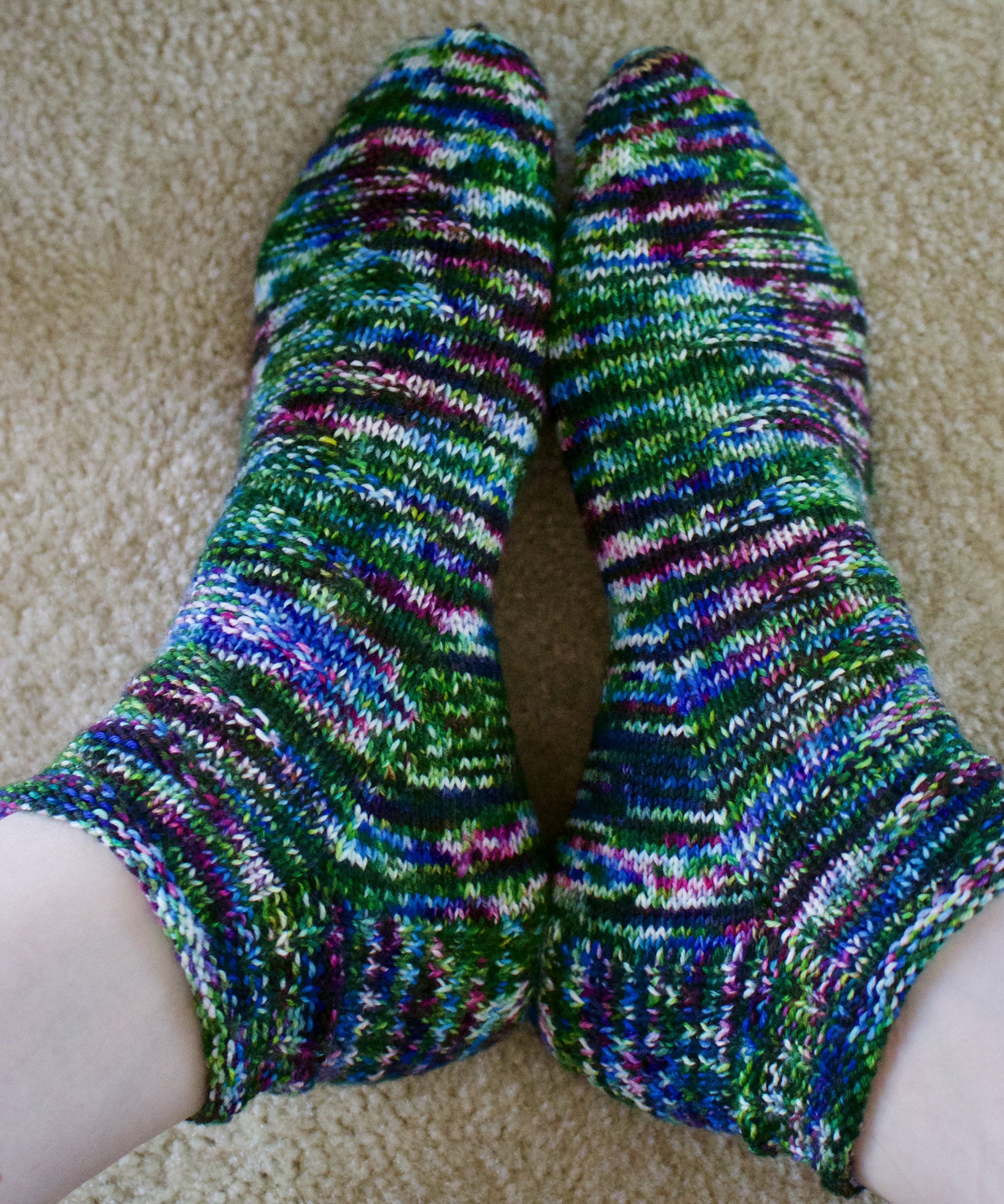
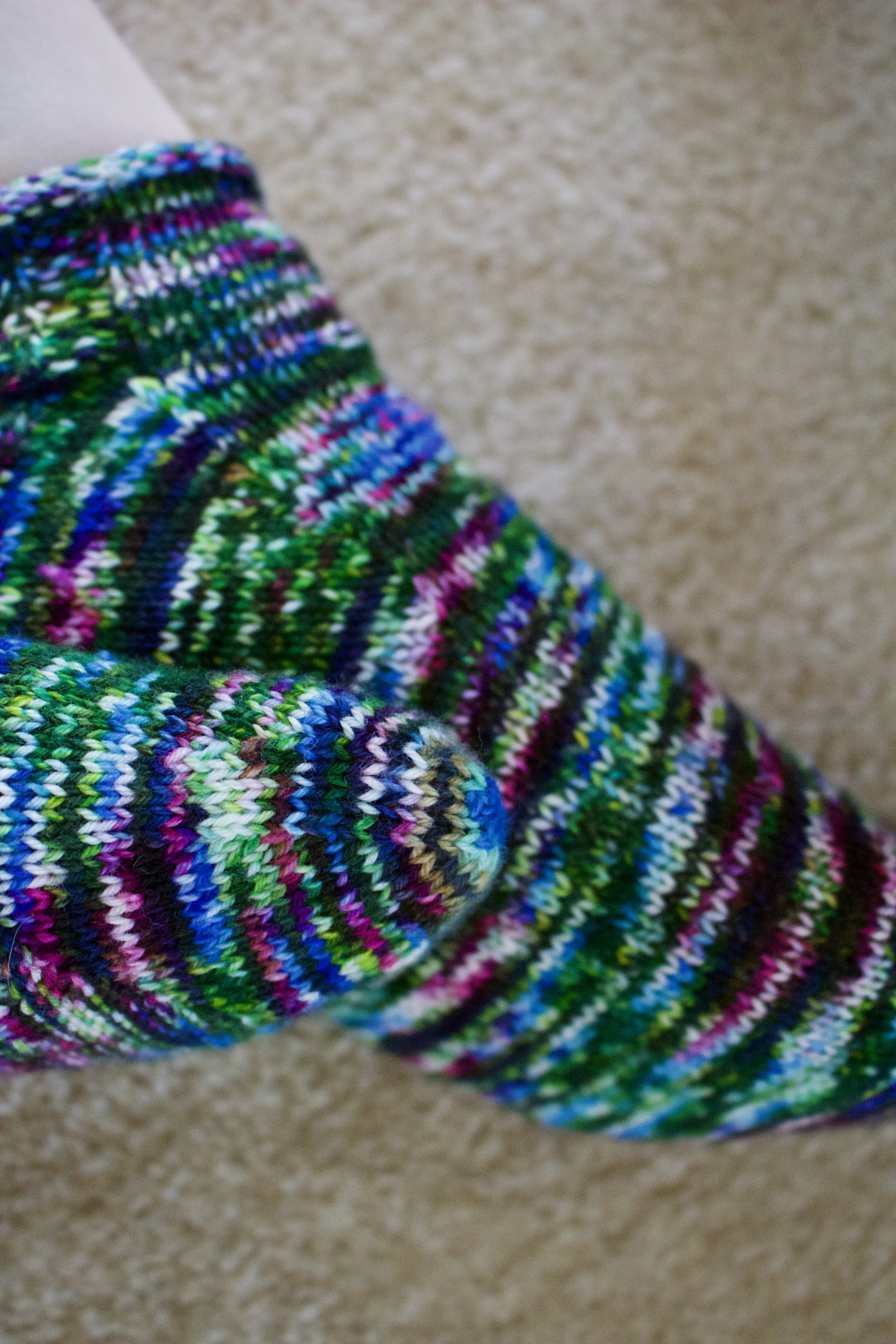
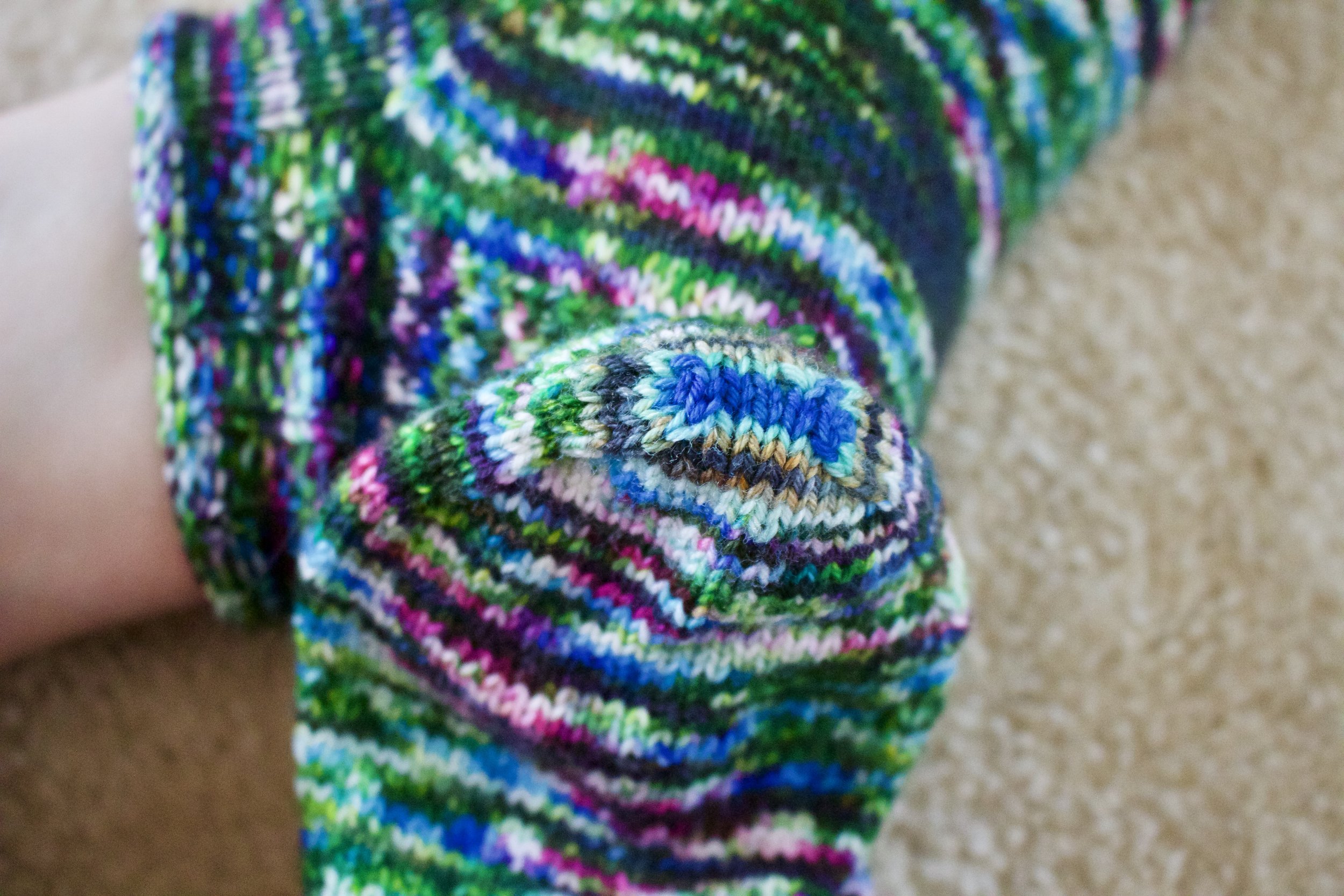
I borrowed the sock blocker from a friend at the yarn store for these pictures. I think I might need to invest in a pair of my own, because the socks look so nice on them!




